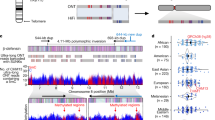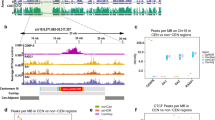Abstract
Chromosome centromeres, composed of repeated DNA sequences, orchestrate the correct segregation of chromatids in cell division. We have examined the centromeres of human chromosomes 13 and 21 by studying the distribution, in situ, of two alpha satellite sequences that differ in a single nucleotide position1. This was possible using padlock probes, oligo-nucleotides that can be ligated into circles upon target recognition2. The segregation of individual 13 and 21 homologues in a family was followed by monitoring of the signals from two differentially labelled probes, specific for either sequence variant. A characteristic arrangement of the repeat motifs in three separate spots, oriented transverse to the length axis of the meta-phase chromosomes and bilaterally symmetric, indicates that only parts of the detected regions are involved in the centromeric region, joining the sister chromatids before anaphase.
This is a preview of subscription content, access via your institution
Access options
Subscribe to this journal
Receive 12 print issues and online access
$209.00 per year
only $17.42 per issue
Buy this article
- Purchase on Springer Link
- Instant access to full article PDF
Prices may be subject to local taxes which are calculated during checkout
Similar content being viewed by others
References
Jørgensen, A.L., Bostock, C.J. & Bak, A.L. Homologous subfamilies of human alphoid repetitive DNA on different nucleolus organizing chromosomes. Proc. Natl. Acad. Sci. USA 84, 1075–1079 (1987).
Nilsson, M. et al. Padlock probes: circularizing oligonucleotides for localized DNA detection. Science 265, 2085–2088 (1994).
Fire, A. & Xu, S.-Q. Rolling replication of short DNA circles. Proc. Natl. Acad. Sci. USA 92, 4641–4645 (1995).
Liu, D., Daubendiek, S.L., Zillman, M.A., Ryan, K. & Kool, E.T. Rolling circle DNA synthesis: small circular oligonucleotides as efficient templates for DNA polymerases. J. Am. Chem. Soc. 118, 1587–1594 (1996).
Landegren, U., Kaiser, R., Sanders, J. & Hood, L. A ligase-mediated gene detection technique. Science 241, 1077–1080 (1988).
Barany, F. Genetic disease detection and DNA amplification using cloned thermostabile ligase. Proc. Natl. Acad. Sci. USA 88, 189–193 (1991).
Koch, J., Kølvraa, S., Petersen, K., Gregersen, N. & Bolund, L. Oligonucleotide-priming methods for the chromosome-specific labelling of alpha satellite DNA in situ. Chromosoma 98, 259–265 (1989).
Koch, J., Hindkjaer, J., Kølvraa, S. & Bolund, L. Construction of a panel of chromosome-specific oligonucleotide probes (PRINS-primers) useful for the identification of individual human chromosomes in situ. Cytogenet. Cell Genet. 71, 142–147 (1995).
Pellestor, F., Girardet, A., Andreo, B. & Charlieu, J.-P. A polymorphic alpha satellite sequence specific for human chromosome 13 detected by oligonucleotide primed in situ labelling (PRINS). Hum. Genet. 94, 346–348 (1994).
Pellestor, F., Girardet, A., Genevieve, L., Andreo, B. & Charlieu, J.P. Use of the primed in situ labelling (PRINS) technique for a rapid detection of chromosomes 13, 16, 18, 21, X and Y. Hum. Genet. 95, 12–17 (1995).
Charlieu, J.-P. et al. Discrimination between alpha satellite DNA sequences from chromosomes 21 and 13 by using polymerase chain reaction. Genomics 14, 515–516 (1992).
Wevrick, R. & Willard, H.F. Long-range organization of tandem arrays of alpha satellite DNA at the centromeres of human chromosomes: high-frequency array-length polymorphism and meiotic stability. Proc. Natl. Acad. Sci. USA 86, 9394–9398 (1989).
O'Keefe, C.L., Warburton, P.E. & Matera, A.G. Oligonucleotide probes for alpha satellite DNA variants can distinguish homologous chromosomes by FISH. Hum. Mol. Genet. 5, 1793–1799 (1996).
Trowell, H.E., Nagy, A., Vissel, B. & Choo, K.H.A. Long-range analyses of the centromeric regions of human chromosomes 13, 14 and 21: identification of a narrow domain containing two key centromeric DNA elements. Hum. Mol. Genet. 2, 1639–1649 (1993).
Finelli, P. et al. Structural organization of multiple alphoid subsets coexisting on human chromosomes 1, 4, 5, 7, 9, 15, 18, and 19. Genomics 38, 325–330 (1996).
Connolly, B.A. Solid phase 5′-phosphorylation of oligonucleotides. Tetrahedron Lett. 28, 463–466 (1987).
Sund, C., Ylikosli, J., Hurskainen, P. & Kwiatkowski, M. Construction of europium (Eu3+)-labelled oligo DNA hybridization probes. Nucleosides Nucleotides. 7, 655–659 (1988).
Kwiatkowski, M., Nilsson, M. & Landegren, U. Synthesis of full-length ligonudeotides: cleavage of apurinic molecules on a novel support. Nucleic Acids Res. 24, 4632–4638 (1996).
Wu, D.Y. & Wallace, R.B. Specificity of the nick-closing activity of bacteriophage T4 DNA ligase. Gene 76, 245–254 (1989).
Lou, J., Bergstrom, D.E. & Barany, F. Improving the fidelity of Thermus thermophilus DNA ligase. Nucleic Acids Res. 24, 3071–3078 (1996).
Pinkel, D. et al. Fluorescence in situ hybridization with human chromosome specific libraries: detection of trisomy 21 and translations of chromosome 4. Proc. Natl Acad. Sci. USA 85, 9138–9142 (1988).
Willard, H.F. & Waye, J.S. Hierarchical order in chromosome-specific human alpha satellite DNA. Trends Genet. 3, 192–198 (1987).
Greig, G.M., Warburton, P.E. & Willard, H.F. Organization and evolution of an alpha satellite DNA subset shared by human chromosomes 13 and 21. J. Mol. Evol. 37, 464–475 (1993).
Marcais, B. et al. Structural organization and polymorphism of the alpha satellite DNA sequences of chromosomes 13 and 21 as revealed by pulse field gel electrophoresis. Hum. Genet. 86, 311–316 (1991).
Marcais, B. et al. On the mode of evolution of alpha satellite DNA in human populations. J. Mol. Evol. 33, 42–48 (1991).
Author information
Authors and Affiliations
Corresponding authors
Rights and permissions
About this article
Cite this article
Nilsson, M., Krejci, K., Koch, J. et al. Padlock probes reveal single-nucleotide differences, parent of origin and in situ distribution of centromeric sequences in human chromosomes 13 and 21. Nat Genet 16, 252–255 (1997). https://doi.org/10.1038/ng0797-252
Received:
Accepted:
Issue Date:
DOI: https://doi.org/10.1038/ng0797-252
This article is cited by
-
Addressing widespread misidentifications of traditional medicinal mushrooms in Sanghuangporus (Basidiomycota) through ITS barcoding and designation of reference sequences
IMA Fungus (2021)
-
Graphene oxide-based fluorometric determination of microRNA-141 using rolling circle amplification and exonuclease III-aided recycling amplification
Microchimica Acta (2019)
-
Rapid Identification of Seven Waterborne Exophiala Species by RCA DNA Padlock Probes
Mycopathologia (2018)
-
Morphology-oriented epigenetic research
Histochemistry and Cell Biology (2018)
-
Quantitative measurement of cancer tissue biomarkers in the lab and in the clinic
Laboratory Investigation (2015)



